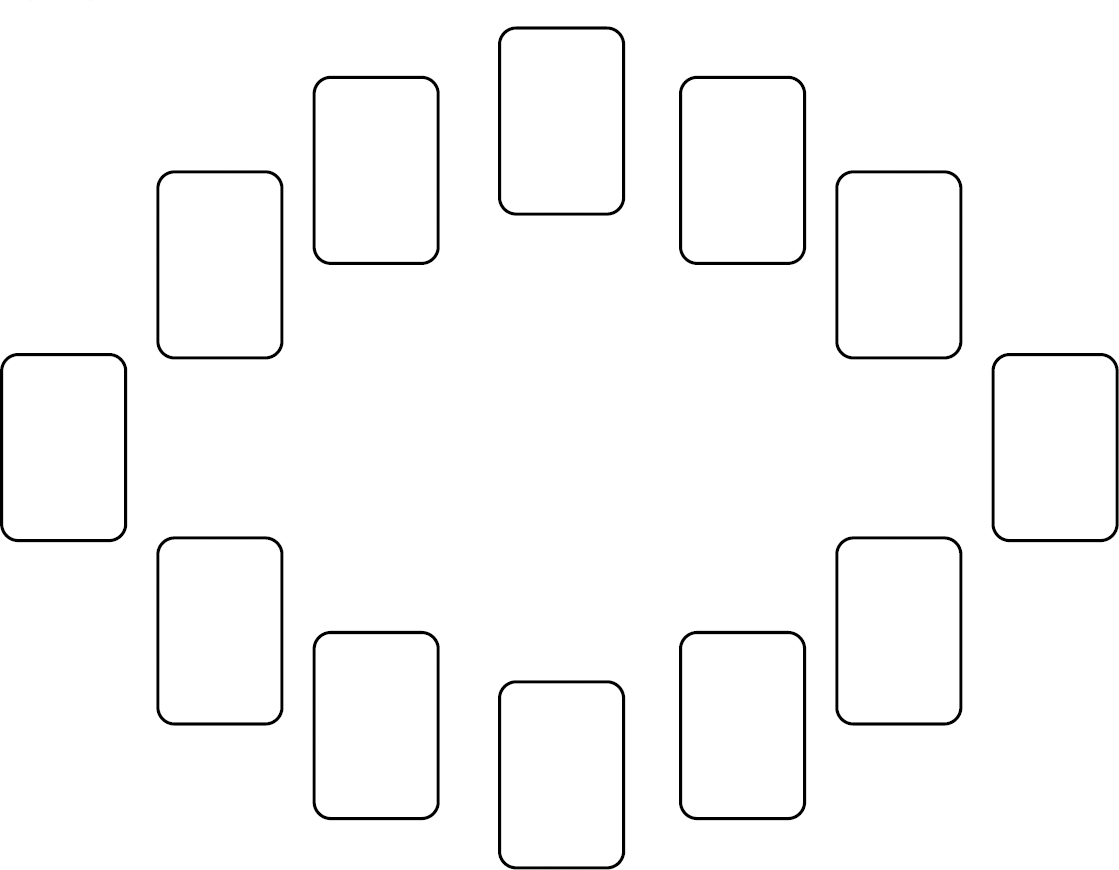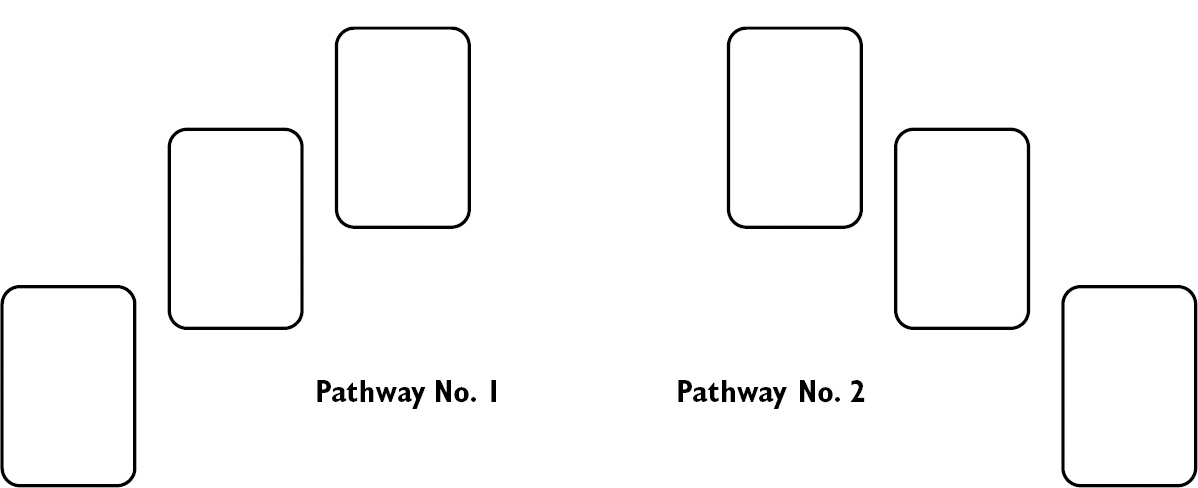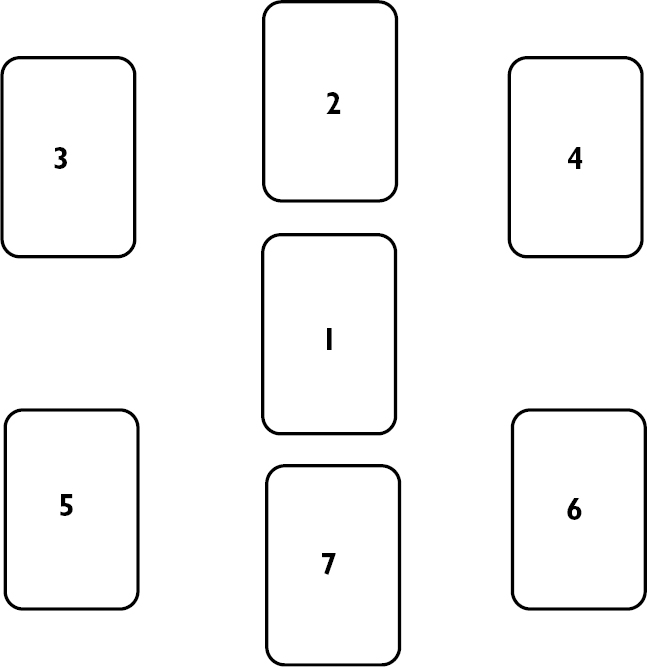By now you will have realized that a comprehensive spread is one that takes a look at the Questioner's position as a whole, without focusing upon any particular aspect of it. These spreads can be very simple or extremely complicated, as we shall see shortly. The interpretation of some spreads relies upon the Reader having other forms of esoteric knowledge, such as astrology, numerology, or the Kabbala.
I expect you are familiar with the traditional horseshoe spread, which uses seven cards in a horseshoe shape. In its most simple version the cards indicate 1) Past, 2) Present, 3) Future, 4) Personal attitudes, 5) Others' attitudes, 6) Obstacles, and 7) Outcome. The spread presented here is a double-horseshoe spread, which I picked up from Taroist Tina Brooks. It has the advantage of looking at the Questioner's whole situation, putting the reading in more comprehensive context of past, present, and future. It can take a pressing situation and expose a good course of action.
Arrange the cards as shown on page 126. The position meanings are:
This spread requires a thorough understanding of the Kabbala, so if you are interested, I suggest that you get together with people who understand Kabbalistic techniques and see whether you can work with them. Douglas Ashby, who is a teacher of the Kabbala, provided the details of the system given below.
The Tree of Life is made up of ten Sephiroth, plus one special position called Daath, or Da'at. Daath isn't easy to explain; in very simple terms, one view is that it's considered to be a perfect combination of all ten Sephiroth together. Thus, it's usually left out of this spread.
However, you may wish to experiment by placing a final card on the Daath position, to represent an overall feel for the reading. For example, if the card turned out to be The Lovers, it could imply a romantic inclination for the reading. If that works for you, then it is valid for you.
Each of the Sephiroth has a series of meanings within it and is also like a computer subdirectory, meaning that it carries within it an extended Tree system that can be used for further and deeper study of the system. The origins of the Kabbala are ancient and it became a core belief system amongst religious Jews who were looking for a system of understanding the workings of the universe and an esoterically spiritual way of life.
The names shown on the diagram are the traditional Hebrew ones, and the descriptions given below are only a few of the many different attributes allocated to each of the Sephiroth. These will suffice for our present purposes, though.
Kether Spiritual impulse, higher self, spiritual influences surrounding one, the roots of new things due to come into one's life. Conception of anything. Cards: The four Aces.
‘Hokma Male image, how one relates to the active male force, new things starting to come into being. Left side of the head. First month of pregnancy. Father. Cards: The four Twos.
Binah Feminine image, how one relates to the receptive, structuring processes of life, right side of the head, second month of pregnancy. Mother. Cards: The four Threes.
‘Hesed Ideals, the law, religious matters, one's inner will, planning processes, compassionate nature, left shoulder and arm, third month of pregnancy. Female relatives. Cards: The four Fours.
Geburah Active aspirations, ability to act, determination, strength, ability to destroy the past in order to create the future, right shoulder and arm, fourth month of pregnancy. Male relatives. Cards: The four Fives.
Tiphareth Control, balance, harmony, heart center, center of being, lungs, solar plexus, active will, things now definitely in the process of coming to fruition. The fifth month of pregnancy. Husband in female reading. Cards: The four Sixes.
Netzach Emotional nature, feelings, desires, artistic creativity, romance, left hand and hip-back-loin, sons, the sixth month of pregnancy. Cards: The four Sevens.
Hod Thoughts, communication, speech, logic, right hand and hip-back-loins, sons, the seventh month of pregnancy. Cards: The four Eights.
Yesod Imagination, instincts, habit patterns, sex, food, home environment, sexual organs. Eighth month of pregnancy. Wife in a male reading. Cards: The four Nines.
Malkuth General physical condition and environment, what is happening now and just past, legs and feet. All things that have now come into manifestation or that are passing away. The ninth month of pregnancy. Birth and death. Cards: The four Tens.
A numerological approach can be used in various spreads, the first of which is similar to the astrological spread because it gives an overview of the Questioner's situation. The basic idea is to use nine cards and look at them in the context of their numerological positions. Many numerologists also use the numbers eleven and twenty-two, which are considered especially significant, but for the purposes of this reading, nine cards are sufficient.
1. Ambition, action, aggressive energy, mental “muscle,” the start of an enterprise.
2. Partnership, harmony, peace, and moderation. The start of a new relationship.
3. Creativity, new beginnings that involve other people, and material benefits to come from partnerships. Possibly the birth of a child.
4. Security practicalities, the foundation of anything, also restrictions and limitations, parents, authority figures, a workable routine.
5. Activity, the need to break out of an established routine, travel, change, marketing oneself or one's products.
6. Home and family duties and ties, giving love, warmth, food, and security. Harmony, health, and caring for the welfare of others.
7. Rest, relaxation, and time off to think things over. The occult or religious and spiritual ideas. Reflection and analysis.
8. Material success and also spiritual attainment. Progress and balance between the two, bringing achievement and success. Money and business matters will prosper.
9. Perfection, completion, detached love, humanitarianism. The end of a phase or the loss of some aspect of one's life, which clears the way for another cycle to begin. Reaching a higher level in one's spiritual attainment, improving one's karma.
1. Judgment: This card would suggest that rather than starting an enterprise, a long-standing course of action is being brought to an end.
2. Page of Wands: A partnership in connection with writing, communicating, and education is about to start.
3. Ace of Coins: A new beginning that involves others and that will be financially beneficial.
4. Ten of Coins: The financial and working aspects of the future look secure.
5. Nine of Cups: A change of direction will be satisfactory and pleasurable.
6. The Moon: There will be unexpected problems and benefits in the area of the home and family. Something is not quite right here, but the situation is not ready to reveal itself yet. Something to do with water may cause a problem.
7. Eight of Coins: The spiritual side of life will bring some kind of new or more important work into being. There will be little time for rest or relaxation.
8. Eight of Wands (reversed): The reversed aspect of this card shows that although the Questioner will be extremely successful, the workload may be too heavy and may not lead to any kind of personal growth.
9. Page of Cups: Something completely new will come of these changes, which will bring some kind of emotional or spiritual satisfaction. There will be new methods to be learned and new people entering and influencing the Questioner's life.
You can use numerology and the Tarot as a simple oraculum by taking three cards, adding their numbers together and seeing what you have. For the three-card Oraculum in the below example, we are using the Minor Arcana. In this case, Ace = 1, and the Court cards are 11, 12, 13, and 14 respectively for Page, Knight, Queen, and King. If your total is twenty-two or less, then refer to the Major Arcana card that corresponds to the number that you have. If the number exceeds twenty-two, reduce the total as demonstrated below to see which Major Arcana card it refers to.

Reduce your total: 2 + 8 = 10. The tenth Major Arcana card is the Wheel of Fortune, so the advice to the Questioner would be to expect changes and to make use of them in a positive manner.
You can also use this method incorporating the Major Arcana cards, and reducing the power of their number to a single Major.
It's possible to do the same sort of thing with the I Ching. There are sixty-four hexagrams in the I Ching, and so sixty-four numbers. Let's see which number a group of three cards would give us:
The thirty-second hexagram of the I Ching reads something like this: Stay put, persevere, and allow things to take their course. Hastiness will bring problems. Don't insist on having things all your own way, because a casual attitude would be far better. Wait, be yourself, and you will get all that you want.
In addition, you may want to also look at how the sum for this layout adds up to the Major Arcana card, the fifth Major, The Hierophant. The keywords here are: Traditional and conventional behavior.
The synchronicity here is interesting! Always push yourself to find new, intuitive, and out-of-the-box ways to interpret your cards.
A great many Tarot Readers use this spread, even those who have very little true astrological knowledge. It's my personal favorite and I always like to begin my readings with it in order to gain an overview of the Questioner's current and future circumstances.
The card layout and astrological house position meanings are shown in the illustration for this spread on page 134.
I have demonstrated this in a previous book, but I will explain its use here for the benefit of those of you who are interested in transactional analysis. The idea is to take one card to represent the Questioner. Then take two cards each for the animus, anima, and the child. The animus is the father figure within all of us who tells us what we should be doing, whether we want to or not. The anima is the mother figure in all of us, reminding us of our duty to ourselves and to humanity; while the child is the hidden side that reveals what we really want.

In this case, start at the twelve o'clock position and take one card for each month of the year ahead.

This will show Questioners what would happen if they chose one of two paths forward. The example below is given in answer to a question such as, “shall I change my job or stay where I am?”

This is another very useful spread that I use a lot, which focuses on the consequences of a particular situation. A Reader called Christina Artemis first demonstrated it to me.

In this spread, you read the answer to the client's specific question according to the sequence of cards that are chosen, laying them out as illustrated above.
The spread works like this:
This spread can be used with the Major Arcana cards alone, or with the whole pack.
This ever-popular spread can be used with the whole pack or with the Major Arcana cards only. I have gone into it in detail in my previous books and I think it must appear in almost every book written on the Tarot. If you find that the order in which I read the cards is a little different from that in some other books, it's because different Readers each do it in slightly different ways.
The spread works as follows:
